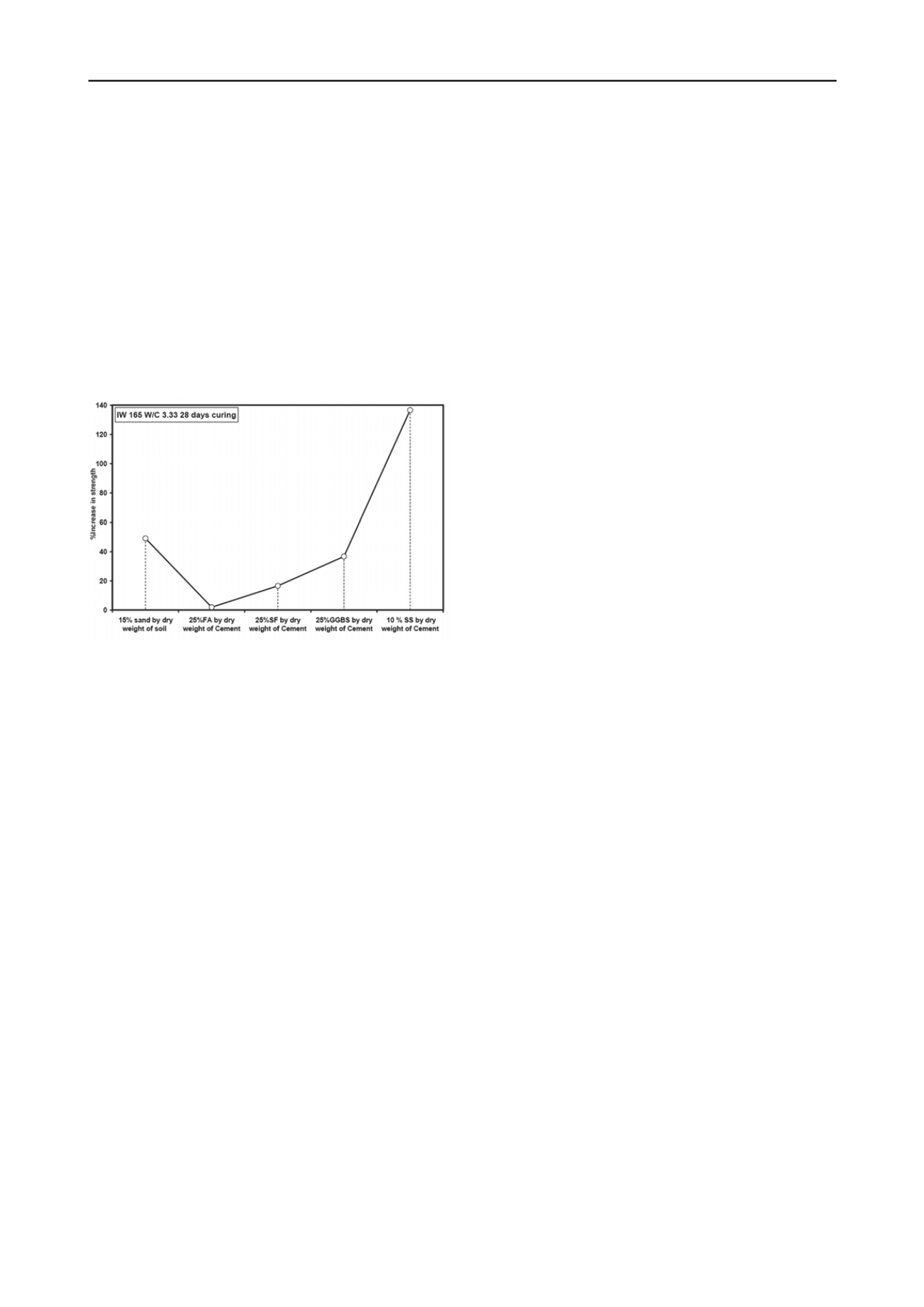
432
Proceedings of the 18
th
International Conference on Soil Mechanics and Geotechnical Engineering, Paris 2013
Proceedings of the 18
th
International Conference on Soil Mechanics and Geotechnical Engineering, Paris 2013
Compared to other additives tried along with cement to
improve the strength of the stabilized soil, Sodium Silicate
added about 10 % by dry weight of cement resulted in
maximum increase of UCC strength. From Figure 7 it can be
seen that the strength increase compared to cement alone at 28
days curing was about 137 %. Initially when sodium silicate is
added to the soil, the negative silicate ions go and sit in the
positive edges of the clay and makes the clay completely
negative resulting in thorough dispersion of the clay. Then
when cement is mixed with soil the calcium ions released as a
by-product of cement hydrolysis is utilized by the silicate ions
leading to the formation of calcium silicate hydrate which
eventually binds the clay minerals together (Moayedi et al.
2011). This is expected to be the mechanism behind enormous
strength gain in the presence of small percentage of SS with
cement.
5 REFERENCES
Thiyyakkandi S. and Annex S. 2011. Effect of Organic Content on
Geotechnical Properties of Kuttanad Clay. Electronic Journal of
Geotechnical Engineering, 16, 1653 – 1663.
Muralidharan P., Rattan R. K. and Datta S. P. 1999. Phosphorus and
iron adsorption characteristics of acid saline soils of Kuttanad,
Kerala. J. Tropical Agric., 37(1-2), 46-50.
Ramanatha Ayyar, T.S. 1966. Strength characteristics of Kuttanad
clays. PhD Thesis, University of Roorkee, India.
Bindu J. and Vinod P. 2008. Mini-plate Load Test on Preloaded
Kuttanad Clays. Proceedings of Indian Geotechnical Conference,
Bangalore.
Dipty S. I. and Girish M. S. 2009. Suitability of Different Materials for
Stone Column Construction. Electronic Journal of Geotechnical
Engineering, 14.
Bergado D. T., Ruenkrairergsa T., Taesiri Y., and Balasubramaniam
A.S. 1999. Deep soil mixing to reduce embankment settlement.
Ground Improvement J., 3(3), 145–162.
Lin, K.Q. and Wong, I.H. 1999. Use of deep cement mixing to reduce
settlements at bridge approaches. J. Geotech. Geoenviron. Eng.,
ASCE, 125(4), 309-320.
Lorenzo G. A. and Bergado. D. T. 2004. Fundamental parameters of
cement-admixed clay-new approach. J. Geotech. Geoenviron. Eng.,
ASCE, 130(10), 1042–1050.
Horpibulsuk S., Miura N. and Nagaraj T.S. 2005. Clay–water/cement
ratio identity of cement admixed soft clay. J Geotech Geoenviron
Eng., ASCE, 131(2), 187–92.
Rajasekaran G. 2006. Influence of microfossils and pyrites on the
behaviour of oceanbed sediments. Ocean Engineering, 33,517–529.
Horpibulsuk S., Miura N. and Bergado D.T. 2004. Undrained shear
behavior of cement admixed clay at high water content. J. Geotech.
Geoenviron. Eng., ASCE, 130(10), 1096-1105.
Miura N., Horpibulsok S. and Nagaraj T. S. 2001. Engineering behavior
of cement stabilized clay at high water content. Soils Found., 41(5),
33–45.
Chen H and Wang Q. 2006. The behaviour of organic matter in the
process of soft soil stabilization using cement. B. Eng. Geo.
Environ.., 65(4), 445-448.
Figure 7. Percentage increase in UCC strength of cement stabilized soil
upon adding various additives
4 CONCLUSIONS
The following conclusions can be drawn from the present study
o
In case of cement stabilization W/C ratio is the key
parameter controlling the strength of the treated soil
samples. Higher initial water content requires more
cement content to attain desired strength as compared
to the soil treated at lower initial water content for the
same water cement ratio. Effect of curing is almost
negligible because of the organic constituents present
in the soil.
Åhnberg H. and Johansson S.E. 2005. Increase in strength with time in
soils stabilised with different types of binder in relation to the type
and amount of reaction products. Proceedings of the International
Conference on Deep Mixing, Stockholm, Vol.1.1.
Van Capellen P., Dixit S. and van Bennekom A. J. 2001. Processes
controlling solubility of biogenic silica and pore water build-up of
silicic acid in marine sediments. Mar. Chem., 73, 333– 352.
Taylor H.F.W. 1997. Cement chemistry, Thomas Telford, London.
o
Replacement of cement by quick lime is found to be
ineffective as the organic component of the soil
inhibits lime from reacting with the clay minerals.
Hence lime and lime substitutes will not work in case
of stabilizing Kuttanad clay.
Moayedi H., Huat B.K., Moayedi F., Asadi A., and Parsaie A. 2011.
Effect of Sodium Silicate on Unconfined Compressive Strength of
Soft Clay. Electronic Journal of Geotechnical Engineering, 16, 289-
295.
o
The solubility of Diatom silica is affected by the
organic matter and sesquioxides present in the soil
making the soil less responsive to lime. Thus
supplying reactive silica by other additives along with
cement is necessary for improving the strength of the
soil.
o
Among the additives used with varying quantities of
reactive silica, small percentage of Sodium Silicate
with cement is found to be most effective in
enhancing the strength of cement stabilized Kuttanad
soil.


